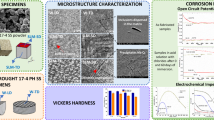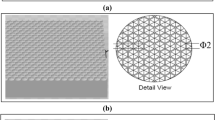Abstract
Surface modification through surface mechanical attrition treatment (SMAT) process and annealing were employed to enhance the corrosion properties of 316 stainless steel (SS) in 0.6 M NaCl. SMAT resulted in the formation of a nanocrystalline layer on 316 SS with an average grain size of 20 nm at the depth of about 30 µm from the treated surface. The nanocrystalline microstructure of the surface was characterized by X-ray diffraction and scanning electron microscopy. The micro-hardness of the surface layer of the treated sample was higher than that of the as-received sample by about 100 HV (Vickers hardness) at a depth of 200 µm from the treated surface. By the combined effect of SMAT and low-temperature annealing treatment at 400 °C, the electrochemical tests revealed an improvement in the corrosion properties of 316 SS in terms of corrosion potential and current density. This was attributed to the easy movement of Cr from the material matrix to the surface layer which resulted in the formation of a protective oxide layer on the material surface.













Similar content being viewed by others
References
Tao NR, Wang ZB, Tong WP, Sui ML, Lu J, Lu K (2002) An investigation of surface nanocrystallization mechanism in Fe induced by surface mechanical attrition treatment. Acta Mater 50:4603–4616
Zhu KY, Vassel A, Brisset F, Lu K, Lu J (2004) Nanostructure formation mechanism of α-titanium using SMAT. Acta Mater 52:4101–4110
Zhang HW, Hei ZK, Liu G, Lu J, Lu K (2003) Formation of nanostructured surface layer on AISI 304 stainless steel by means of surface mechanical attrition treatment. Acta Mater 51:1871
Wang ZB, Tao NR, Li S, Wang W, Liu G, Lu J, Lu K (2003) Effect of surface nanocrystallization on friction and wear properties in low carbon steel. Mater Sci Eng A 352:144–149
Tao NR, Sui ML, Lu J, Lu K (1999) Surface nanocrystallization of iron induced by ultrasonic shot peening. Nanostruct Mater 11:433
Zhang L, Han Y (2010) Effect of nanostructured titanium on anodization growth of self-organized TiO2 nanotubes. Nanotechnology 21:055602
Wang K, Tao NR, Liu G, Lu J, Lu K (2006) Plastic strain-induced grain refinement at the nanometer scale in copper. Acta Mater 54:5281
Wu X, Tao N, Hong Y, Liu G, Xu B, Lu J, Lu K (2005) Strain-induced grain refinement of cobalt during surface mechanical attrition treatment. Acta Mater 53:681
Wu X, Tao N, Hong Y, Lu J, Lu K (2005) Localized solid-state amorphization at grain boundaries in a nanocrystalline Al solid solution subjected to surface mechanical attrition. J Phys D 38:4140–4143
Chang HW, Kelly PM, Shi YN, Zhang MX (2012) Thermal stability of nanocrystallized surface produced by surface mechanical attrition treatment in aluminum alloys. Surf Coat Technol 206:3970–3980
Wu X, Tao N, Hong Y, Xu B, Lu J, Lu K (2002) Microstructure and evolution of mechanically-induced ultrafine grain in surface layer of AL-alloy subjected to USSP. Acta Mater 50:2075
Chen AY, Ruan HH, Wang J, Chan HL, Wang Q, Li Q, Lu J (2011) The influence of strain rate on the microstructure transition of 304 stainless steel. Acta Mater 59:3697–3709
Dang C, Olugbade TO, Fan S, Zhang H, Gao LL, Li J, Lu Y (2018) Direct quantification of mechanical responses of TiSiN/Ag multilayer coatings through uniaxial compression of micropillars. Vacuum 156:310–316
Lin Y, Lu J, Wang L, Xu T, Xue Q (2006) Surface nanocrystallization by surface mechanical attrition treatment and its effect on structure and properties of plasma nitrided AISI 321 stainless steel. Acta Mater 54:5599
Tao NR, Wu XL, Sui ML, Lu J, Lu K (2004) Grain refinement at the nanoscale via mechanical twinning and dislocation interaction in a nickel-based alloy. J Mater Res 19:1623
Tao NR, Zhang HW, Lu J, Lu K (2003) Development of nanostructures in metallic materials with low stacking fault energies during surface mechanical attrition treatment (SMAT). Mater Trans 44:1919
Sun HQ, Shi YN, Zhang MX, Lu K (2007) Plastic strain-induced grain refinement in the nanometer scale in Mg alloy. Acta Mater 55:975
Tao NR, Lu J, Lu K (2008) Surface nanocrystallization by surface mechanical attrition treatment. Mater Sci Forum 579:91–108
Ren JW, Shan AD, Zhang JB, Song HW, Liu JL (2006) Surface nanocrystallization of Ni3Al by surface mechanical attrition treatment. Mater Lett 60:2076–2079
Balusamy T, Sankara Narayanan TSN, Ravichandran K (2012) Effect of surface mechanical attrition treatment (SMAT) on boronizing of EN8 steel. Surf Coat Technol 213:221–228
Dang C, Yao Y, Olugbade TO, Li J, Wang L (2018) Effect of multi-interfacial structure on fracture resistance of composite TiSiN/Ag/TiSiN multilayer coating. Thin Solid Films 653:107–112
Barbucci A, Faroe G, Matteazzi P et al (1999) Corrosion behaviour of nanocrystalline Cu90Ni10 alloy in neutral solution containing chlorides. Corros Sci 41:463
Vinogradov A, Mimaki T, Hashimoto S et al (1999) On the corrosion behaviour of ultra-fine grain copper. Scr Mater 41:319
Balyanov A, Kutnyakova J, Amirkhanova NA et al (2004) Corrosion resistance of ultra fine-grained Ti. Scr Mater 51:225
Balusamy T, Kumar S, Sankara Narayanan TSN (2010) Effect of surface nanocrystallization on the corrosion behavior of AISI 409 stainless steel. Corros Sci 52:3826–3834
Zheng ZJ, Gao Y, Gui Y, Zhu M (2012) Corrosion behaviour of nanocrystalline 304 stainless steel prepared by equal channel angular pressing. Corros Sci 54:60–67
Ye W, Li Y, Wang FH (2006) Effect of nanocrystallization on the corrosion behavior of 309 stainless steel. Electrochim Acta 51:4426–4432
Li Y, Fang F, Liu G (2004) Grain size effect on the electrochemical corrosion behavior of surface nanocrystallized low-carbon steel. Corrosion 60:891–896
Arifvianto B, Mahardika SM (2012) Effects of surface mechanical attrition treatment (SMAT) on a rough surface of AISI 316L stainless steel. Appl Surf Sci 258:4538–4543
Kwok CT, Cheng FT, Man HC, Ding WH (2006) Corrosion characteristics of nanostructured layer on 316 l stainless steel fabricated by cavitation-annealing. Mater Lett 60:2419–2422
Kikuchi S, Komotori J (2010) Properties of gas nitrided austenitic stainless steel pre-treated with fine particle peening. Int J Fatigue 32:403–410
Mahagaonkar SB, Brahmankar PK, Seemikeri CY (2009) Effect on fatigue performance of shot peened components: an analysis using DOE technique. Int J Fatigue 31:693–702
Dai K, Villegas J, Stone Z, Shaw L (2004) Finite element modeling of the surface roughness of 5052 Al alloy subjected to a surface severe plastic deformation process. Acta Mater 52:5771–5782
Abioye TE, Olugbade TO, Ogedengbe TI (2017) Welding of dissimilar metals using gas metal arc and laser welding techniques: a review. J Emerg Trends Eng Appl Sci 8:225–228
Ogedengbe T, Olugbade TO, Olagunju O (2015) Application of house of quality matrix to material selection for engineering designs. Br J Appl Sci Technol 10:1–11
Liu G, Lu J, Lu K (2000) Surface nanocrystallization of 316L stainless steel induced by ultrasonic shot peening. Mater Sci Eng A 286:91–95
Anand Kumar S, Ganesh S, Sankara Narayanan TSN, Gnanamoorthy R (2012) Fretting wear behaviour of surface mechanical attrition treated alloy 718. Surf Coat Technol 206:4425–4432
Arifvianto B, Suyitno M, Mahardika P, Dewo PT, Iswanto UA (2011) Effect of surface mechanical attrition treatments (SMAT) on microhardness, surface roughness, and wettability of AISI 316L. Mater Chem Phys 125:418–426
Laleh M, Kargar F (2011) Effect of surface nanocrystallization on the microstructural and corrosion characteristics of AZ91D magnesium alloy. J Alloys Compd. 509:9150–9156
Acknowledgements
Professor J. Lu acknowledges the supports of the National Key R&D Program of China (Project No. 2017YFA0204403) and the Major Program of National Natural Science Foundation of China: NSFC 51590892. This work was also supported by the Government of Hong Kong, Hong Kong SAR, China, Hong Kong (PF16-02783). T. Olugbade appreciates the efforts of Dr Chan Lap Chung and Dr Liu Chang (City University of Hong Kong) for their assistance in the SMAT process and corrosion test, respectively.
Author information
Authors and Affiliations
Corresponding author
Ethics declarations
Conflict of interest
The authors report no conflict of interest.
Rights and permissions
About this article
Cite this article
Olugbade, T., Lu, J. Enhanced Corrosion Properties of Nanostructured 316 Stainless Steel in 0.6 M NaCl Solution. J Bio Tribo Corros 5, 38 (2019). https://doi.org/10.1007/s40735-019-0235-7
Received:
Revised:
Accepted:
Published:
DOI: https://doi.org/10.1007/s40735-019-0235-7




